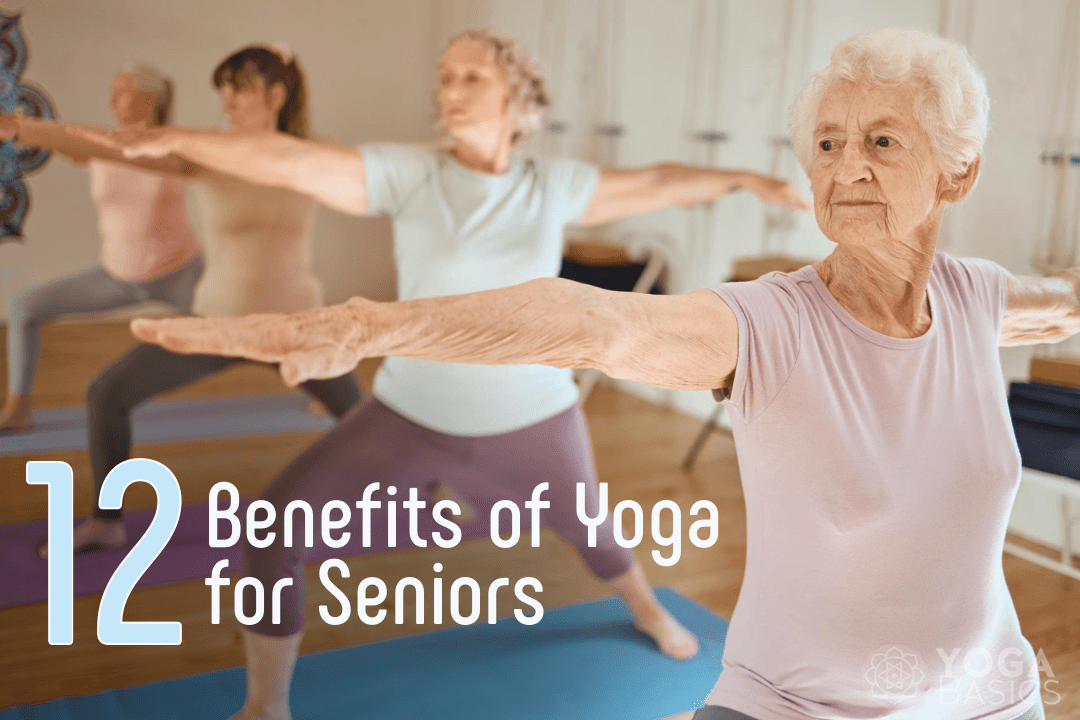As people age, they often face challenges such as decreased mobility, balance issues, joint pain, and various health conditions. Yoga provides a gentle yet effective way to address these issues, while improve flexibility, strength, balance, and cardiovascular health and promoting overall well-being. helps. It may not be easy to start a yoga practice later in life, but seniors are increasingly seeking out classes as they hear more and more about yoga’s physical and mental health benefits.
Benefits of yoga for the elderly
Many older adults are led to believe that yoga is only for the young and bendy. But, the truth is that yoga is a practice that can benefit people of all ages! By incorporating yoga into their daily life, older adults can experience improved physical health and a greater sense of mental and emotional well-being. Here are the top twelve ways that yoga can be beneficial to seniors and older adults:
1. Improves Muscle Tone
As we age, muscle mass naturally begins to deteriorate. Engaging in even a gentle hatha yoga practice can have a beneficial effect on strengthening and toning muscles. Plank pose, Downward-Facing Dog, Warrior I, and Warrior II are good for building strength, especially for those new to the practice.
2. Enhances Flexibility
Over time and with decreased activity, muscles lose some of their elasticity, making even common everyday tasks like tying your shoes more difficult. For those with decreased flexibility, try Seated Forward Bend with or without a yoga strap to stretch the shoulders and hamstrings; Cat and Cow poses to bring flexibility to the spine; low lunge to open the hip flexors; and side-bending Cresent Moon pose to elongate the muscles along the torso.
3. Eases Aches and Pains
Studies show that yoga is effective at treating some forms of chronic pain, including pain and stiffness from arthritis and repetitive stress syndrome. Yoga poses are gentler than some weight-bearing exercises that can put excess stress on the joints, and it helps to reduce overall tension. Cobra and Child’s pose both help ease back pain. Bound Angle pose helps with hip pain. Standing Forward Fold increases flexibility in the spine and hamstrings, targeting achy low backs.
4. Improves Balance
Impaired balance is common among adults over age 65, and in some cases, problems with balance can lead to dangerous falls that cause serious injuries. Practicing balancing postures in yoga can help strengthen the muscles that stabilize the body while walking and standing. Depending on the individual, yoga postures like Tree, Side Plank, and Half Moon help build better balance. Holding onto a wall or a prop is a good place to begin for those who find balancing on one foot a challenge.
5. Builds Stronger Bones
A decrease of bone density is one of the biggest concerns among aging adults. Research has found that yoga improves bone density in people who have suffered from bone loss, including those with osteoporosis or osteopenia. Many of the physical postures use opposing muscle groups and gravity to put pressure on the bones, which increases the production of bone-growing cells. Triangle pose, Warrior I and II, and Plank pose all emphasize opposing muscles.
6. Increases Concentration
Changes in the brain that happen as we age mean that some older adults have a harder time with concentration and multitasking. Techniques such as pranayama and meditation stimulate the brain and nervous system to improve concentration and memory. In pranayama, focusing on the breath allows the mind to be still and the nervous system to enter a relaxed state. Meditation also calms the mind, and when practiced regularly over time, meditation helps keep distracting thoughts at bay.
7. Boosts Mood
Some older adults experience feelings of loneliness and isolation, and attending a yoga class can be a great way to build friendships and a sense of community. What’s more, yoga is a proven mood-booster1. Heart-opening poses and gentle back bends like Cobra, Bow pose, and Bridge pose are shown to increase positive moods in individuals who suffer from depression. Practicing asana, pranayama, and meditation contribute to an overall improved mood, more energy, and decreased anxiety.
8. Improves Posture
As we age, poor posture can become a common issue due to muscle weakness and joint stiffness. Yoga can significantly help by encouraging proper alignment and strengthening the muscles that support good posture. Poses like Downward Facing Dog pose, Seated Twist pose, Standing Yoga Mudra pose, and Cobra pose are especially effective in promoting better posture. Regular practice of these poses helps to lengthen the spine, open up the chest, and draw the shoulders back. This not only improves posture but also eases strain on the neck and low back, making everyday activities more comfortable.
9. Improves Quality of Sleep
Many older adults struggle with sleep issues, ranging from insomnia to disrupted sleep patterns. Yoga has been shown to improve sleep quality by promoting relaxation and reducing stress levels. Incorporating gentle yoga stretches and breathing exercises, such as Child’s pose, Seated Forward Bend, Supine Twist, Happy Baby pose and Corpse pose before bedtime can help calm the mind and prepare the body for restful sleep. Additionally, practices like yoga nidra, a guided meditation technique, can be particularly beneficial for inducing deep relaxation and enhancing overall sleep quality. By integrating a few asanas into their daily routine, seniors may find themselves falling asleep more easily and enjoying a more restorative night’s sleep.
10. Improves Heart Health
Regular yoga practice is a gentle yet effective way to support cardiovascular health and help prevent heart disease in seniors. Studies have shown that yoga can help lower blood pressure, reduce cholesterol levels, and improve heart rate variability, all of which are crucial for maintaining a healthy heart. Poses that focus on gentle stretching and breathing, such as Bridge pose, Legs Up the Wall, and Corpse pose, encourage relaxation and reduce stress, which are key factors in heart health. Additionally, incorporating pranayama (breathing exercises) can enhance oxygenation of the blood and promote better circulation. By integrating these practices into their routine, older adults can experience improved cardiovascular function and a reduced risk of heart-related issues.
11. Slows Cellular Aging
Scientific evidence shows that a daily yoga practice can counteract the aging processes at a cellular level2. Yoga helps in reducing genomic instability by decreasing levels of DNA damage, to protect cells from oxidative damage and stress, and to increases the length and activity of telomeres (which protect chromosomes). Promoting cellular health and longevity is a key factor in preventing the onset of age-related diseases.
12. Boosts Cognitive Functions
Older adults who engage in yoga practice have shown improvements in cognitive functions related to aging. Anatomical changes were observed in brain regions responsible for cognitive decline with regular yoga practice. Research shows that seniors engaging in specific asanas demonstrate increased hippocampal volume, improved gray matter volume in frontal regions, and enhanced connectivity within the default mode network, vital for memory and self-awareness3. Functional changes include more efficient neural processing during cognitive tasks and improved emotional processing. These findings suggest that yoga can support cognitive resilience against age-related decline and neurodegenerative diseases, making it a valuable tool for maintaining cognitive health and overall well-being in seniors.
What types of yoga are best for seniors?
Gentle forms of yoga such as Hatha, Iyengar, and restorative yoga are recommended for seniors. Hatha yoga focuses on basic postures, gentle stretches and breathing techniques, making it accessible for beginners. Iyengar yoga emphasizes proper alignment and often uses props like blocks, bolsters, straps, and chairs to support the body, making it suitable for those with limited mobility. Restorative yoga involves passive stretching and relaxation poses, which help reduce stress and promote healing. Chair yoga is another excellent option for seniors who may have difficulty getting up and down from the floor. These gentle practices prioritize safety and accessibility, ensuring that seniors can enjoy the benefits of yoga without the risk of injury.
A number of yoga studios, senior living facilities, hospitals, and health care centers offer yoga classes that cater specifically to older adults and those with impaired mobility. There are also many free yoga classes on YouTube tailored specifically for older adults. These videos will guide you through gentle exercises that can help improve your flexibility, strength, and overall well-being from the comfort of your home. Check out our post on: The Best Yoga for Seniors YouTube Videos.
It’s always a good idea for people with medical conditions to consult with a doctor before beginning any kind of yoga practice or physical exercise.
How often should seniors do yoga?
Practicing yoga three to five times a week will lead to significant improvements in flexibility, strength, balance, and overall health. However, even one or two sessions per week can be beneficial. It’s important for seniors to listen to their bodies and avoid overexertion, especially if they are new to yoga or have existing health conditions. Starting with shorter sessions of 20-30 minutes and gradually increasing the duration as they become more comfortable can help build a sustainable practice. Consistency is key, and incorporating asanas, mindful breathing, and meditation into their daily routine can help seniors maintain their physical and mental well-being as they age.
Final thoughts
Yoga has the power to heal and transform us at any age. For the elderly, practicing yoga can bring a multitude of benefits that can enhance their overall well-being and quality of life. One of the key advantages of yoga for seniors is its ability to improve flexibility and balance, helping to prevent falls and injuries. It also promotes strength and muscle tone, which can aid in maintaining independence and carrying out daily activities with ease. Additionally, the social aspect of attending a yoga class can provide a sense of community and connection for elderly individuals, combating feelings of loneliness and isolation. It is never too late to start a yoga practice and experience the incredible benefits it can offer!

